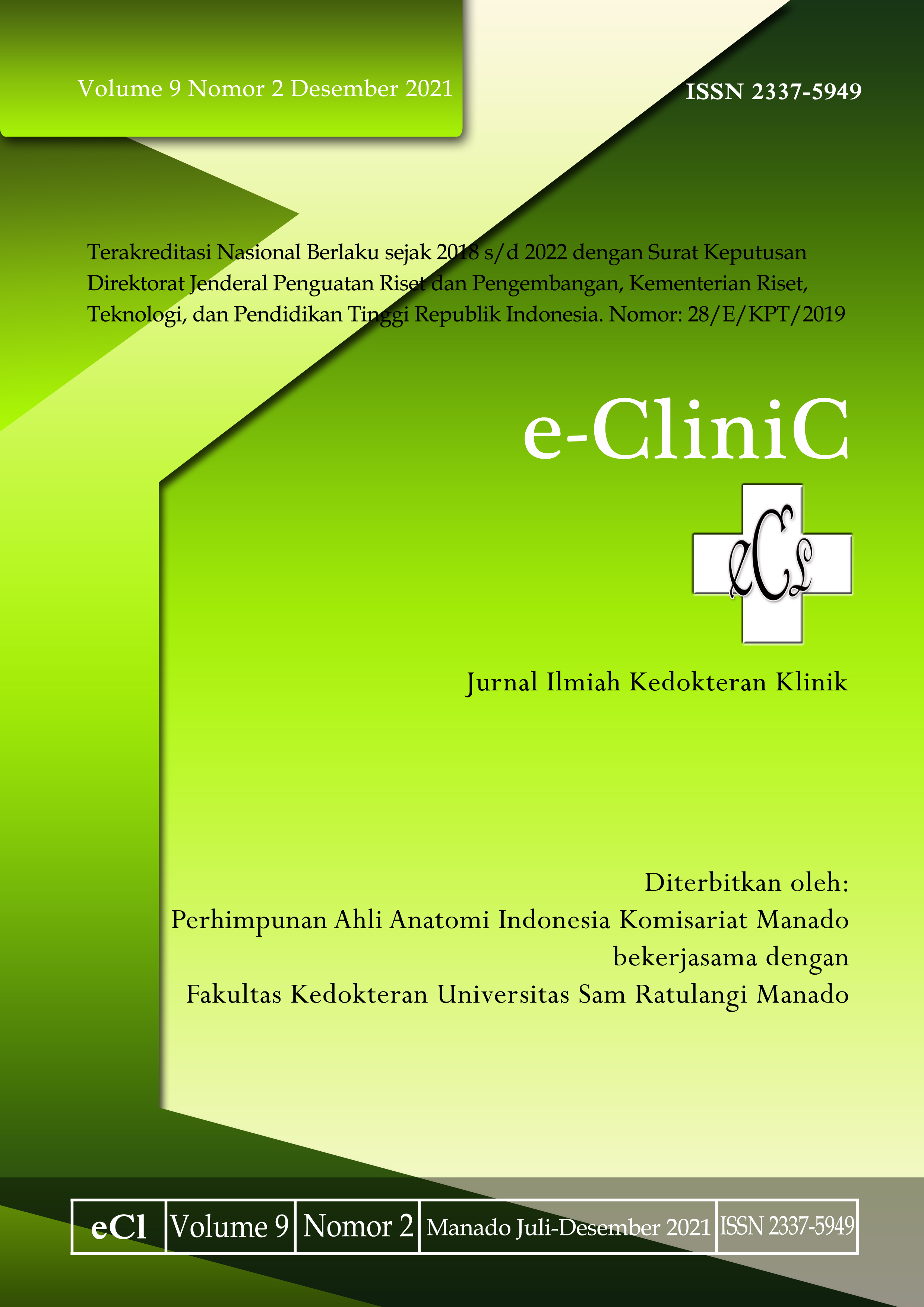Hubungan Kadar Laminin Serum dengan Tingkat Kesadaran Menurut Skor FOUR pada Pasien Cedera Otak Akibat Trauma
DOI:
https://doi.org/10.35790/ecl.v9i2.35901Abstract
Abstract: Traumatic brain injury (TBI) could result in disorders of central nervous system (CNS). Serum laminin level and the FOUR score have both been suggested as predictors for the outcomes after TBI. This study was aimed to evaluate the relationship between serum laminin level and the FOUR score in TBI patients. This was an observational and analytical study with a cross-sectional design. Subjects were 32 patients with TBI and FOUR scores of 0-16 admitted at the Emergency Surgery Installation of Prof. Dr. R. D. Kandou Hospital. Venous blood sample for laminin was taken less than 24 hours after trauma. Assessment of the level of consciousness was determined by using the FOUR score at Emergency Surgery Installation admission <24 hours and observation after >24 hours. Proportional regression model was used to assess changes in FOUR score associated with laminin level. The results obtained 32 patients with TBI, mean laminin level was 818.4 pg/mL with range IQR 597.4-1235.4 pg/mL. In final regression model, each increase of one unit of pre-24 hours FOUR score decreased serum laminin level by 54.4 pg/mL (95% CI -76.3; 32.1 pg/mL, p<0.001). Same as the relationship occurred for the FOUR score after 24 hours, but the decrease was slightly smaller, at 37.2 pg/mL (95% CI -50.2; -24.3 pg/mL, p<0.001). FOUR scores with a high risk of mortality were more likely to be found in relatively high serum laminin levels. In conclusion, there is a relationship between serum laminin level and the FOUR score. Increase in serum laminin level is a potential alternative to lower FOUR score and to predictof poorer outcome in patient with TBI.
Keywords: laminin; FOUR score; traumatic brain injury (TBI)
Â
Abstrak: Pada cedera otak akibat trauma (COT) sering terjadi gangguan saraf pusat. Laminin serum dan skor FOUR disarankan sebagai prediktor luaran setelah COT. Penelitian ini bertujuan untuk mengevaluasi hubungan antara kadar laminin serum dan skor FOUR pada pasien COT. Jenis penelitian ialah analitik observasional dengan desain potong lintang. Penelitian dilaksanakan pada 32 pasien dengan COT dan skor FOUR 0-16 yang masuk ke Instalasi Rawat Darurat Bedah (IRDB) RSUP Prof. Dr.R. D. Kandou, Manado. Sampel darah vena untuk pemeriksaan serum laminin diambil kurang dari 24 jam setelah trauma. Penilaian tingkat kesadaran ditetapkan dengan skor FOUR saat masuk IRDB <24 jam dan observasi setelah >24 jam. Model regresi proporsional digunakan untuk menilai hubungan kadar laminin serum dengan skor FOUR. Hasil penelitian mendapatkan 32 pasien dengan COT. Rerata kadar laminin serum 818,4 pg/mL dengan range IQR 597,4-1.235,4 pg/mL. Pada model regresi akhir, setiap peningkatan satu unit skor FOUR pra 24 jam rata-rata menurunkan kadar laminin serum sebesar 54,4 pg/mL (95% CI -76,3; 32,1 pg/mL, p<0,001). Hubungan sejenis terjadi untuk skor FOUR pasca 24 jam, tetapi nilai penurunannya sedikit lebih kecil, yakni 37,2 pg/mL (95% CI -50,2; -24,3 pg/mL, p<0,001). Skor FOUR dengan risiko mortalitas tinggi lebih cenderung ditemukan pada kadar laminin serum relatif tinggi. Simpulan penelitian ini ialah terdapat hubungan antara kadar laminin serum dengan skor FOUR. Peningkatan kadar laminin serum merupakan alternatif potensial skor FOUR yang lebih rendah untuk memrediksi luaran yang lebih buruk pada pasien COT.
Kata kunci: laminin; skor FOUR; cedera otak akibat trauma (COT)
Downloads
Published
How to Cite
Issue
Section
License
COPYRIGHT
Authors who publish with this journal agree to the following terms:
Authors hold their copyright and grant this journal the privilege of first publication, with the work simultaneously licensed under a Creative Commons Attribution License that permits others to impart the work with an acknowledgment of the work's origin and initial publication by this journal.
Authors can enter into separate or additional contractual arrangements for the non-exclusive distribution of the journal's published version of the work (for example, post it to an institutional repository or publish it in a book), with an acknowledgment of its underlying publication in this journal.
Authors are permitted and encouraged to post their work online (for example, in institutional repositories or on their website) as it can lead to productive exchanges, as well as earlier and greater citation of the published work (See The Effect of Open Access).







